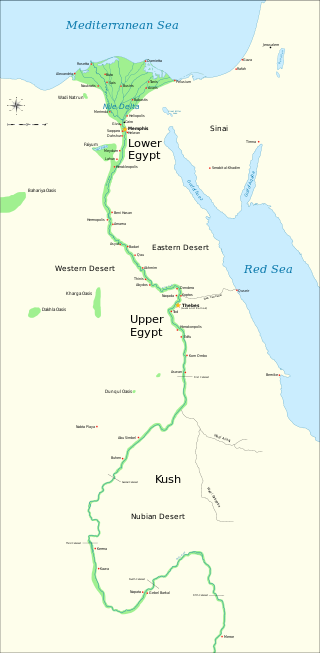
The First Intermediate Period, described as a 'dark period' in ancient Egyptian history, spanned approximately 125 years, c. 2181–2055 BC, after the end of the Old Kingdom. It comprises the Seventh, Eighth, Ninth, Tenth, and part of the Eleventh Dynasties. The concept of a "First Intermediate Period" was coined in 1926 by Egyptologists Georg Steindorff and Henri Frankfort.

The Middle Kingdom of Egypt is the period in the history of ancient Egypt following a period of political division known as the First Intermediate Period. The Middle Kingdom lasted from approximately 2040 to 1782 BC, stretching from the reunification of Egypt under the reign of Mentuhotep II in the Eleventh Dynasty to the end of the Twelfth Dynasty. The kings of the Eleventh Dynasty ruled from Thebes and the kings of the Twelfth Dynasty ruled from el-Lisht.
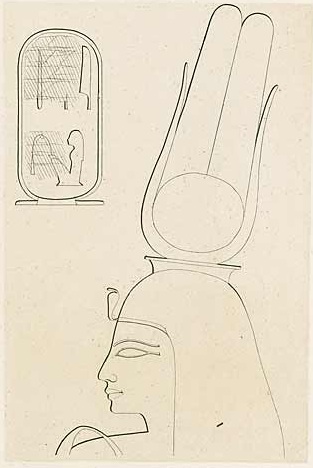
Tey was the Great Royal Wife of Kheperkheprure Ay, who was the penultimate pharaoh of Ancient Egypt's Eighteenth Dynasty. She also had been the wet nurse of Nefertiti.

Mentuhotep II, also known under his prenomen Nebhepetre, was an ancient Egyptian pharaoh, the sixth ruler of the Eleventh Dynasty. He is credited with reuniting Egypt, thus ending the turbulent First Intermediate Period and becoming the first pharaoh of the Middle Kingdom. He reigned for 51 years, according to the Turin King List. Mentuhotep II succeeded his father Intef III on the throne and was in turn succeeded by his son Mentuhotep III.
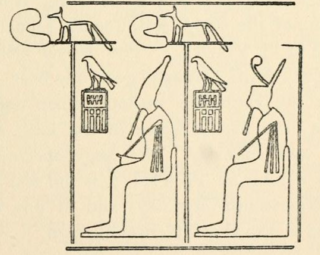
Djer is considered the third pharaoh of the First Dynasty of ancient Egypt in current Egyptology. He lived around the mid 31st century BC and reigned for c. 40 years. A mummified forearm of Djer or his wife was discovered by Egyptologist Flinders Petrie, but was discarded by Émile Brugsch.

Mentuhotep I may have been a Theban nomarch and independent ruler of Upper Egypt during the early First Intermediate Period. Alternatively, Mentuhotep I may be a fictional figure created during the later Eleventh Dynasty, which rose to prominence under Intef II and Mentuhotep II, playing the role of a founding father.
Intef III was the third pharaoh of the Eleventh Dynasty of Egypt during the late First Intermediate Period in the 21st century BC, at a time when Egypt was divided in two kingdoms. The son of his predecessor Intef II and father of his successor Mentuhotep II, Intef III reigned for 8 years over Upper Egypt and extended his domain North against the 10th Dynasty state, perhaps as far north as the 17th nome. He undertook some building activity on Elephantine. Intef III is buried in a large saff tomb at El-Tarif known as Saff el-Barqa.

Amenemhat II, was the third pharaoh of the 12th Dynasty of ancient Egypt. He was known by his prenomen Nubkaure, which means "Golden are the souls of Re". Although he ruled for at least 35 years, his reign is rather obscure, as well as his family relationships.

Senusret I also anglicized as Sesostris I and Senwosret I, was the second pharaoh of the Twelfth Dynasty of Egypt. He ruled from 1971 BC to 1926 BC, and was one of the most powerful kings of this Dynasty. He was the son of Amenemhat I. Senusret I was known by his prenomen, Kheperkare, which means "the Ka of Re is created." He expanded Egypt that allowed him to rule over an age of prosperity.

Beni Hasan is an ancient Egyptian cemetery. It is located approximately 20 kilometers (12 mi) to the south of modern-day Minya in the region known as Middle Egypt, the area between Asyut and Memphis.
The necropolis of Meir is an archaeological site in Middle Egypt in the Asyut Governorate located on the west bank of the Nile. Here are the graves of the nomarchs, mayors and priests of Cusae from the ancient Egyptian Old and Middle Kingdom.
Aylward Manley Blackman, FBA was a British Egyptologist, who excavated various sites in Egypt and Nubia, notably Buhen and Meir. Having taught at Worcester College, Oxford, he was Brunner Professor of Egyptology at the University of Liverpool from 1934 to 1948. He was additionally a special lecturer at the University of Manchester, and was involved in or led a number of excavations with the Egypt Exploration Society.

Neferu II was the wife and sister of the ancient Egyptian king Mentuhotep II who ruled in the 11th Dynasty, around 2000 BC.
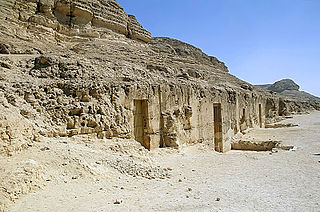
Baqet III was an ancient Egyptian official and Great Chief of the Oryx nome during the 11th Dynasty in the 21st century BCE. Apart from the position of governor of the entire nome, Baqet III also held the titles haty-a, treasurer of the king of Lower Egypt, confidential friend, true royal acquaintance, and mayor of Nekheb.
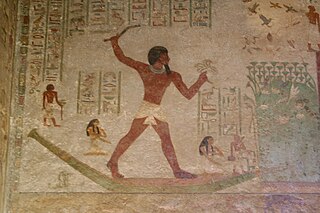
Khnumhotep II was an ancient Egyptian Great Chief of the Oryx nome during the reign of pharaohs Amenemhat II and Senusret II of the 12th Dynasty, Middle Kingdom. He is well known for his tomb at Beni Hasan and its decorations.

Khnumhotep I was an ancient Egyptian Great Chief of the Oryx nome during the reign of Pharaoh Amenemhat I of the 12th Dynasty, Middle Kingdom.

The Oryx nome was one of the 42 nomoi in ancient Egypt. The Oryx nome was the 16th nome of Upper Egypt, and was named after the scimitar oryx. It was located, approximately, in the territories surrounding the modern city of Minya in Middle Egypt.

The Hare nome, also called the Hermopolite nome was one of the 42 nomoi in ancient Egypt; more precisely, it was the 15th nome of Upper Egypt.

Sarenput I was an ancient Egyptian official during the reign of pharaoh Senusret I of the 12th Dynasty.

Djefaihapi was an ancient Egyptian official during the reign of pharaoh Senusret I of the 12th Dynasty. In literature, his name is found written in many other variants such as Hepzefa, Hapidjefa, Hapdjefai, and Djefaihap.

















